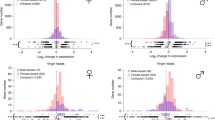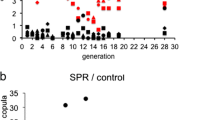Abstract
Determinants of male courtship success in Drosophila melanogasterwere examined in groups of five males sequentially presented with five individual females. Thirty-three percent of males never mated, while approximately half of the males mated two or three times. Rapid courtship initiation was associated with male success in early matings only. Male size was important for courtship outcome, but the size distributions of mating and nonmating males and their progeny numbers indicate balancing rather than directional selection on size- dependent courtship success.
Similar content being viewed by others
References
Boake, C. R. B. (1989). Correlations between courtship success, aggressive success, and body size in a picture-winged fly,Drosophila sylvestris.Ethology 80: 318–329.
Lefevre, G., and Johnson, U. B. (1962). Sperm transfer, storage, displacement and utilization inDrosophila melanogaster.Genetics 47: 1719–1736.
Long, C. E., Markow, T. A., and Yaeger, P. (1980). Relative male age, fertility and competitive mating success inDrosophila melanogaster.Behav. Genet. 10: 163–170.
Malagowolkin-Cohen, C., Simmons, A. S., and Levene, H. (1965). A study of sexual isolation between certain strains ofDrosophila paulistorum.Evolution 19: 95–103.
Markow, T. A. (1987). Genetic and sensory basis of sexual selection inDrosophila. In Huettel, M. D. (ed.),Evolutionary Genetics of Invertebrate Behavior, Plenum, New York, pp. 89–95.
Markow, T. A. (1988). Reproductive behavior ofDrosophila melanogaster andDrosophila nigrospiracula in the field and in the laboratory.J. Comp. Psychol.
Markow, T., Quaid, M., and Kerr, S. (1978). Male mating experience and competitive courtship success inDrosophila melanogaster.Nature 276: 821–822.
Partridge, L., Ewing, A., and Chandler, A. (1987). Male size and mating success inDrosophila melanogaster.Anim. Behav. 35: 555–562.
Pitnick, S. S. (1991). Male size influences mate fecundity and remating interval inDrosophila melanogaster.Anim. Behav. 41: 735–746.
Reeve, E. C. (1950). Genetical aspects of size allometry.Proc. R. Soc. Lond. Ser. B 137: 515–518.
Robertson, F. W., and Reeve, E. (1952). Studies in quantitative inheritance. I. The effects of selection on wing and thorax length inDrosophila melanogaster.J. Genet. 50: 414–448.
Stalker, H. D. (1942). Sexual isolation studies in the species complexDrosophila virilis.Genetics 27: 238–257.
Stromnaes, O., and Kvelland, I. (1962). Sexual activity ofDrosophila melanogaster males.Hereditas 50: 492–270.
Sturteuvant, A. H. (1915). Experiments on sex recognition and the problem of sexual selection inDrosophila.J. Anim. Behav. 5: 351–366.
Author information
Authors and Affiliations
Rights and permissions
About this article
Cite this article
Markow, T.A., Sawka, S. Dynamics of mating success in experimental groups ofDrosophila melanogaster (Diptera: Drosophilidae). J Insect Behav 5, 375–383 (1992). https://doi.org/10.1007/BF01049845
Accepted:
Issue Date:
DOI: https://doi.org/10.1007/BF01049845




